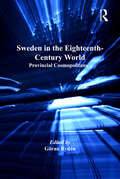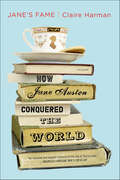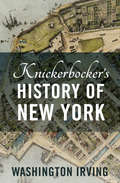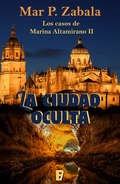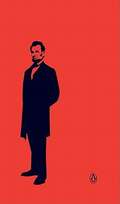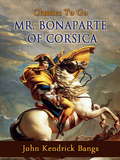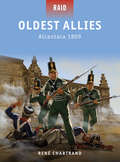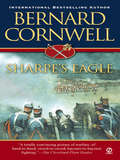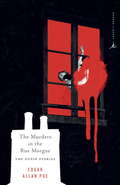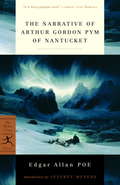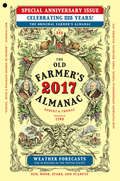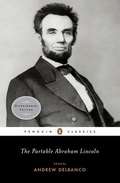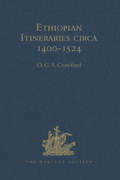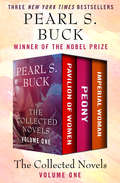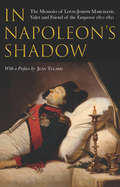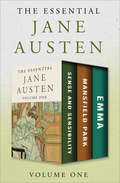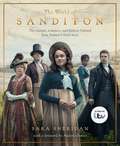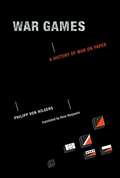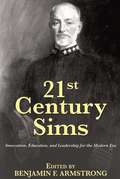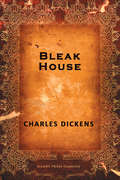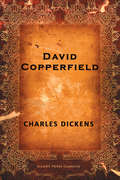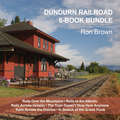- Table View
- List View
Población y sociedad. México (1808-1830)
by Sonia Pérez ToledoLa investigadora e historiadora Sonia Pérez Toledo traza una clara exposición con un tratamiento riguroso de cómo al igual que en política, cultura y economía, en esta etapa la sociedad mexicana experimentará un proceso vivo de transformación, no sólo en cifras de población sino en costumbres y formas de vida. La colección América Latina en la Historia Contemporánea es uno de los proyectos editoriales más importantes de las últimas décadas y una aportación original y novedosa a la historiografía sobre América Latina en la que han participado más de 400 historiadores de diversos países. Presenta una visión plural y accesible de la historia contemporánea de las naciones latinoamericanas -incluyendo aquellas otras, europeas o americanas, que más han aportado a su materialización- y revela las claves políticas, sociales, económicas y culturales que han determinado su trayectoria y el lugar en el mundo que hoy ocupan. Distinciones: Premio dela revista La Aventura de la Historia a la mejor iniciativa editorial
Sweden in the Eighteenth-Century World: Provincial Cosmopolitans
by Göran RydénEighteenth-century Sweden was deeply involved in the process of globalisation: ships leaving Sweden’s central ports exported bar iron that would drive the Industrial Revolution, whilst arriving ships would bring not only exotic goods and commodities to Swedish consumers, but also new ideas and cultural practices with them. At the same time, Sweden was an agricultural country to a large extent governed by self-subsistence, and - for most - wealth was created within this structure. This volume brings together a group of scholars from a range of disciplinary backgrounds who seek to present a more nuanced and elaborated picture of the Swedish cosmopolitan eighteenth century. Together they paint a picture of Sweden that is more like the one eighteenth-century intellectuals imagined, and help to situate Sweden in histories of cosmopolitanism of the wider world.
Jane's Fame: How Jane Austen Conquered the World
by Claire HarmanJane's Fame tells the fascinating story of Jane Austen's renown, from the years of rejection the author faced during her lifetime to the global recognition and adoration she now enjoys. Almost two hundred years after her death, Austen remains a hot topic, constantly open to revival and reinterpretation and known to millions of people through film and television adaptations as much as through her books. In Jane's Fame, Claire Harman gives us the complete biography—of both the author and her lasting cultural influence—making this essential reading for anyone interested in Austen's life, works, and remarkably potent fame.
Knickerbocker's History of New York: Complete
by Washington IrvingThis nineteenth-century novel by the author of Rip Van Winkle offers a satirical history of New York, from the creation of the world to the fall of New Amsterdam.Washington Irving&’s debut novel, Knickerbocker&’s History of New York was an immediate sensation when it was first published in 1809. Posing as the work of a fictional Dutch historian named Dietrich Knickerbocker, it both catapulted Irving&’s literary reputation and established the &“Father Knickerbocker&” character as a popular icon of New York. Knickerbocker discusses the development of New Netherland, the seventeenth-century Dutch colony, with a special focus on New Amsterdam, the settlement located on present-day Manhattan. The thoroughly tongue-in-cheek chronicle contains &“among many surprising and curious matters, the unutterable ponderings of Walter the Doubter, the disastrous projects of William the Testy, and the chivalric achievements of Peter [Stuyvesant] the Headstrong.&”
La ciudad oculta (Los casos de Marina Altamirano #Volumen 2)
by Mar P. ZabalaNo te puedes perder este nuevo caso de la brillante policía Marina Altamirano. En esta segunda entrega de la trilogía conoceremos la increíble historia de los pasadizos secretos de la ciudad de Salamanca. Marina Altamirano, convertida en la detective estrella de la comisaria de Salamanca, trabaja a las órdenes de Carlos Tejedor, el que en otro tiempo era su compañero. Una mañana un hotel céntrico de la ciudad amanece con sus puertas cerradas y sus habitaciones vacías. No hay rastro ni de los huéspedes ni del personal que trabaja en él. Los familiares se agolpan en comisaria pidiendo una pronta resolución del caso. La investigación lleva a Marina y a su actual compañero, Pepón García, hasta unos túneles que durante años han permanecido ocultos bajo el subsuelo de la ciudad, comunicando edificios sin que los ojos curiosos de los habitantes puedan verlo. Una emocionante aventura que hará descubrir al lector la historia olvidada de Salamanca y sus misteriosos túneles. «-Despierta, despierta, Rosa, venga que ya es hora de ponerse a trabajar. Odiaba su voz, desde el momento en que interrumpió en su habitación, en donde se sentía a salvo y por fin podía descansar de las noches de hospital. Esa voz, grave, ruda y desagradable que desde aquel día la atormentaba noche y día, aparentando una afabilidad que estaba muy lejos de poseer. Y el olor, una mezcla de mal aliento y tabaco, que a estas alturas, con las fosas nasales inundadas de la pestilencia de aquellos húmedos y oscuros pasadizos, ya casi no notaba. La ropa de abrigo que les habían dado, aquel feo chándal y la sudadera dos tallas más grandes, no parecía ser nunca suficiente para quitarse la sensación de frío. Habían perdido la noción del tiempo, comían cuando les daban algo para hacerlo, caminaban sin rumbo fijo sintiendo el agua llenando las deportivas, que al menos eran de su número, y oyendo las ratas deslizándose junto a ellos.»
Lincoln on the Civil War
by Abraham LincolnCommemorating the 150th anniversary of the beginning of the American Civil War. This well-rounded selection of Abraham Lincoln's finest speeches combines the classic and obscure, the lyrical and historical, and the inspirational and intellectual to present a historical arc marking periods of the Civil War-crisis, outbreak, escalation, victory, and Reconstruction. Addressing the conflict's multiple aspects-the issue of slavery, state versus federal power, the meaning of the Constitution, civic duty, death, and freedom-this elegant keepsake collection will make a wonderful inspirational gift for professed Lincoln fans, Civil War buffs, and lovers of rhetorical genius. .
Los condes no se casan con doncellas (Serie Chadwick #Volumen 3)
by Mariam OrazalTercera y esperada entrega de la serie «Chadwick» de Mariam Orazal, iniciada con La noble ladrona. Ella creía haber olvidado. Él nunca dejó de buscar. Shein Dereford vuelve a Inglaterra tras pasar casi diez años en el servicio secreto. La guerra ha terminado, pero el conde de Redcliff no puede permitir que los crímenes de su mayor enemigo queden impunes. En su búsqueda de la justicia se reencontrará con la mujer que no ha podido sacarse de la cabeza y que, a pesar de no ser más que una traidora, le robó el corazón. Hannah Lubrele ha conseguido la paz que jamás creyó que pudiera sentir. Vive con una familia que la quiere y la respeta y casi ha conseguido olvidar las calamidades por las que ha pasado por culpa del hombre que la traicionó y que casi la conduce a la muerte. Ahora Hannah tendrá que enfrentarse al pasado y reconocer que no ha sido sincera ni con sus seres queridos ni con su propio corazón. Los lectores han dicho sobre entregas anteriores de la serie:«[...] Enhorabuena Mariam, has conseguido crear una divertida, romántica, entretenida y amena historia que recomiendo al 100%. Te seguiré leyendo. Sin duda, una pluma que no hay que perderse.» «[...] Sin duda llega pisando fuerte y espero que lo haga para quedarse... No veo el momento de volver a leer algo suyo. ¡¡Esperemos que no nos haga esperar mucho!!» «Una serie que te atrapa desde el primer momento. Un argumento muy entretenido. Unos personajes con los que vives cada situación, de los que te enamoras. Muy bien escrita, de lectura ágil, fresca. Mi enhorabuena a la autora. la recomiendo. Me ha encantado.»
Mr. Bonaparte of Corsica (Classics To Go)
by John Kendrick BangsExcerpt: ””That settles it," said Napoleon. "It's to be war. I'm willing to divide creation with England, but two's company and three's a crowd, and the Russian Bear must keep his paws off. I will go to Italy, Bourrienne, collect a few more thrones, and then we'll get to work on a new map of Europe. Russia never did look well or graceful on the existing maps...."" By the American author and satirist, and the creator of modern Bangsian fantasy.Very funny spoof biography of Napoleon, almos Marx-esque at some moments. (Goodreads)
Oldest Allies - Alcantara 1809
by Rene Chartrand Mark StaceyAlthough somewhat overshadowed by Wellington's main campaign in the north, the Alcantara raid was an outstanding success. The primary objective of alarming and distracting the French forces in Spain was achieved. Furthermore, the raiders also succeeded in preventing a French incursion into Portugal and tied down one of Napoleon's best marshals. There were further raids to come, but the 1809 Alcantara raid delivered a strong, permanent message: that the Anglo-Portuguese were willing and able to strike back against the French, and that they would support their Spanish allies as much as they were able.
Sharpe's Eagle: Richard Sharpe And The Talavera Campaign, July 1809 (Richard Sharpe Adventure Ser. #No. 8)
by Bernard CornwellAfter the cowardly incompetence of two officers besmirches their name, Captain Richard Sharpe must redeem the regiment by capturing the most valued prize in the French Army--a golden Imperial Eagle, the standard touched by the hand of Napoleon himself.
The Murders in the Rue Morgue
by Edgar Allan Poe Matthew PearlEdited and with an Introduction by Matthew Pearl Includes "The Murders in the Rue Morgue," "The Mystery of Marie Rogêt," and "The Purloined Letter" Between 1841 and 1844, Edgar Allan Poe invented the genre of detective fiction with three mesmerizing stories of a young French eccentric named C. Auguste Dupin. Introducing to literature the concept of applying reason to solving crime, these tales brought Poe fame and fortune. Years later, Dorothy Sayers would describe "The Murders in the Rue Morgue" as "almost a complete manual of detective theory and practice." Indeed, Poe's short mysteries inspired the creation of countless literary sleuths, among them Sherlock Holmes. Today, the unique Dupin stories still stand out as utterly engrossing page-turners. Includes a Modern Library Reading Group GuideFrom the Trade Paperback edition.
The Narrative of Arthur Gordon Pym of Nantucket
by Edgar Allan Poe Jeffrey MeyersAfter reading an 1836 newspaper account of a shipwreck and its two survivors, Edgar Allan Poe penned his only novel, The Narrative of Arthur Gordon Pym of Nantucket, the story of a stowaway on a Nantucket whaleship who finds himself enmeshed in the dark side of life at sea: mutiny, cannibalism, savagery--even death. As Jeffrey Meyers writes in his Introduction: "[Poe] remains contemporary because he appeals to basic human feelings and expresses universal themes common to all men in all languages: dreams, love, loss; grief, mourning, alienation; terror, revenge, murder; insanity, disease, and death." Within the pages of this novel, we encounter nearly all of them.This Modern Library Paperback Classic reprints the text of the original 1838 American edition.From the Trade Paperback edition.
The Old Farmer's Almanac 2017: Special Anniversary Edition
by Old Farmer’s AlmanacWhat is 225 years old yet always of the moment? The Old Farmer's Almanac! America's oldest continuously published periodical, beloved by generations for being "useful, with a pleasant degree of humor," celebrates its unique history with a special edition and more readers than ever before! As the nation's iconic calendar, the 2017 edition will predict and mark notable events; glance back and look forward, with historic perspectives on food, people, and businesses; salute legendary customs and folklore; hail celestial events; explore, forage, and cultivate the natural world; forecast traditionally 80 percent-accurate weather; inspire giggles and perhaps romance; and more--too much more to mention--all in the inimitably useful and humorous way it has done since 1792.
The Portable Abraham Lincoln
by Abraham LincolnCelebrate the bicentennial of Abraham Lincoln's birth with this new edition of his greatest speeches and writings Abraham Lincoln endowed the American language with a vigor and moral energy that has all but disappeared from today's public rhetoric. Lincoln's writings are testaments of our history, windows into his enigmatic personality, and resonant examples of the writer's art. The Portable Abraham Lincoln contains the great public speeches-the first debate with Stephen Douglas, the "House Divided"speech, the Gettysburg Address, the Second Inaugural Address-along with less familiar letters and memoranda that chart Lincoln's political career, his evolving stand against slavery, and his day-to-day conduct of the Civil War. This edition includes a revised introduction, updated notes on the text, a chronology of Lincoln's life, and four new selections of his writing. .
Ethiopian Itineraries circa 1400-1524: Including those Collected by Alessandro Zorzi at Venice in the Years 1519-24 (Hakluyt Society, Second Series)
by O. G. S. CrawfordZorzi's Italian text with translation by C. A. Ralegh Radford. Includes a gazetteer for Fra Mauro's map. This is a new print-on-demand hardback edition of the volume first published in 1958.
The Collected Novels Volume One: Pavilion of Women, Peony, and Imperial Woman
by Pearl S. BuckFrom the Nobel Prize–winning author of The Good Earth: These three novels are fascinating portraits of women in China. In 1938, Pearl S. Buck became the first woman to win a Nobel Prize in Literature for The Good Earth, which had already earned her the Pulitzer Prize. Upon choosing Buck&’s novel for her book club in 2004, Oprah Winfrey said: &“Reading Pearl Buck&’s writing feels like reading poetry to me. I just love the quiet rhythm of the words. They evoke the simple beauty of the characters and the harsh mystery of China&’s ancient culture.&” The daughter of missionaries, the New York Times–bestselling author would continue to explore many aspect of Chinese culture in her work, and the three novels collected in this volume represent some of her most compassionate and revealing fiction. Pavilion of Women: This &“vivid and extremely interesting novel,&” set in early twentieth-century China, follows an upper-class wife&’s quest for personal freedom (The New Yorker). After Madame Wu turns forty, she encourages her husband to take a young concubine so she can finally begin to discover her own mind—and a new world opens up before her as she reads forbidden books and studies English with a progressive former priest. &“Beautifully written . . . A fine, full flavorsome novel.&” —Newsweek Peony: A young Chinese bondmaid in nineteenth-century China falls in love with the son of the wealthy Jewish family she works for. As the couple&’s traditions collide, their relationship faces opposition from every side. &“Peony has the vividness of scene and episode and character and the colorful detail that [Buck&’s] readers have come to expect of her novels in China.&” —New York Herald Tribune Imperial Woman: In this &“richly woven . . . quite absorbing&” New York Times bestseller, Buck brings to life the story of Tzu Hsi, the magnetic and fierce-minded woman who rose from concubine to become the working head of the Qing Dynasty and the last empress of China for nearly half a century (The Nation). &“Certainly, no fictioneer could imagine a more incredible woman. . . . Pearl Buck has done a remarkable and painstaking job in recreating her.&” —Saturday Review
In Napoleon's Shadow: The Memoirs of Louis-Joseph Marchand, Valet and Friend of the Emperor, 1811–1821
by Louis-Joseph MarchandIn 1811, twelve young men were chosen among the families in the Emperors personal service to serve as ushers in his apartments. My mother, attached to the household of the King of Rome as first nurse to the prince, requested this favour for me from the grand chamberlain, the Count de Montesquiou, and it was granted.Louis-Joseph Marchands intimate memoir of his time as Napoleons valet is the last of the significant Napoleonic manuscripts to be translated into English and a unique and precious insight into the last days of Napoleons Imperial project.Serving alongside the Emperor from the apex of his reign and through his eventual demise, Marchand depicts, in remarkable detail, the Russian campaign, the campaigns of Germany and France, Napoleons exile to Elba and subsequent escape, his defeat at Waterloo.Friend and confidante to the leader, Marchand was beside him at the Tuileries during the Hundred Days, and he was present to hear Napoleons last words, France my son the army on the island of St Helena.This sincere and authentic testimony from a man with nothing to hide, nothing to apologise for is both a meticulous historical record and a fresh personal perspective on Napoleon.In this work, Tulard remarks in his preface, the Emperor speaks freely. Listen..Marchand presents the somewhat familiar history of the Emperor's decline as completely new territory through conversations, fond stories and personal encounters'.'Marchand's memoirs, republished in English for the first time in two decades, represent a truly irreplaceable contribution to Napoleonic scholarship. Beyond the Emperor as commander and conqueror, Marchand, from his privileged vantage point, illuminates Napoleon the man in rich and absorbing detail.' - John H Gill
The Essential Jane Austen Volume One: Sense and Sensibility, Mansfield Park, and Emma
by Jane AustenThree books in one volume by the author beloved for her smart, witty novels of Regency England. This collection of Jane Austen&’s novels includes three timeless classics.Sense and Sensibility: Torn between reason and passion, obligation and impulse, two sisters search for love in eighteenth-century England. Mansfield Park: A shy young woman of modest means is sent to live with her wealthy relatives—and discovers her true power—in this poignant love story.Emma: This enchanting romantic comedy stars one of literature&’s most delightful heroines, meddling matchmaker Emma Woodhouse.
The World of Sanditon: The Official Companion to the ITV Series
by Sara SheridanThe official TV tie-in to accompany the ITV drama scripted by Andrew DaviesThe World of Sanditon delves behind the scenes of Sanditon, giving you the inside scoop on Jane Austen's unfinished masterpiece, adapted for television by Andrew Davies.Produced by Red Planet Pictures, ITV's Sanditon series tells the story of the joyously impulsive, spirited and unconventional Charlotte Heywood and her spiky relationship with the humorous, charming and slightly wild Sidney Parker. Written by Emmy and BAFTA-Award winning writer Andrew Davies, the series brought Austen's story to life and this book will allow you to go behind the scenes of the cast and crew, exploring the world that Austen created and offering fascinating insights about the period and about the real-life heartbreak behind her final story. Readers will also have access to location guides, interviews with the cast, and in-depth historical information by esteemed author Sara Sheridan.
War Games: A History of War on Paper
by Philipp Von Hilgers Ross BenjaminFor centuries, both mathematical and military thinkers have used game-like scenarios to test their visions of mastering a complex world through symbolic operations. By the end of World War I, mathematical and military discourse in Germany simultaneously discovered the game as a productive concept. Mathematics and military strategy converged in World War II when mathematicians designed fields of operation. In this book, Philipp von Hilgers examines the theory and practice of war games through history, from the medieval game boards, captured on parchment, to the paper map exercises of the Third Reich. Von Hilgers considers how and why war games came to exist: why mathematical and military thinkers created simulations of one of the most unpredictable human activities on earth. Von Hilgers begins with the medieval rythmomachia, or Battle of Numbers, then reconstructs the ideas about war and games in the baroque period. He investigates the role of George Leopold von Reiswitz's tactical war game in nineteenth-century Prussia and describes the artifact itself: a game board--topped table with drawers for game implements. He explains Clausewitz's emphasis on the "fog of war" and the accompanying element of incalculability, examines the contributions of such thinkers as Clausewitz, Leibniz, Wittgenstein, and von Neumann, and investigates the war games of the German military between the two World Wars. Baudrillard declared this to be the age of simulacra; war games stand contrariwise as simulations that have not been subsumed in absolute virtuality.
21st Century Sims
by Edited by Benjamin F. ArmstrongFor more than two decades at the beginning of the 20th century William S. Sims was at the forefront of naval affairs. From the revolution in naval gunnery that he led as a junior officer, to his advocacy for the Dreadnaught style all-big-gun battleship, to his development of torpedo boat and destroyer operations, he was a central figure in helping to prepare the U. S. Navy for World War I. During the war he served as the senior naval commander in Europe and was instrumental in the establishment of the convoy system that won the Battle of the Atlantic. Following the war his leadership as President of the Naval War College established the foundations of the creative and innovative Navy that would develop the operating concepts for submarines and aircraft carriers which would lead to success in World War II. Despite his dramatic impact on the U. S. Navy in the first half of the 20th century, Sims is a relatively unknown figure today. Overshadowed in our memory by the World War II generation of strategic Admirals, like Chester Nimitz and Raymond Spruance, he receives little attention from historians or professional naval officers. Despite the fact that he won a Pulitzer Prize for history, hardly anyone reads the books or articles he left as his legacy. This collection of six essays written by Sims illustrates why his thinking and leadership are relevant to the challenges faced in the 21st century. From the perils of military conservatism, to the responsibilities of the professional officer, to military downsizing and reform, he helped lay the foundations of the modern Navy. Armstrong’s introductions and analysis of these essays links them directly to the issues of innovation, professional education, and leadership that are as important at the start of this century as they were at the start of the last.
Bleak House: In Four Volumes, Volume 1...
by Charles DickensThe story of a lengthy, byzantine court-case, Bleak House brings together some of Dickens' most memorable characters in an intertwining story of love, murder and greed. At the centre is a case of Jarndyce vs. Jarndyce, a generations long battle over inheritance that connects all the principal characters, including the heroine Esther Summerson, a prospective beneficiary of the will Richard Carstone, the wealthy and kind John Jarndyce and the villainous lawyer Mr. Tulkington. Involving many, engaging sub-plots Bleak House is also an attack on the flaws of Britain's legal system of the time. It is not only considered one of Dickens best works but has been credited with helping to spark demand for real judicial reform after its publication in 1853.
David Copperfield: Roman Anglais. Tome 2
by Charles DickensThe eighth novel from one of the English language's most important writers, Charles Dickens' David Copperfield is considered a masterpiece. Originally published in 1850, the book tells the titular character's life story as he escapes an unhappy childhood with his stepfather and strikes out on his own, encountering a memorable cast of characters. Through his life, David encounters comedy and tragedy, kindness and cruelty and grows as a character. There are many details in the book drawn from Dickens' own life, and he referred to the character of Copperfield as his "favourite child".
Dundurn National Historic Site: Inside Hamilton's Museums
by John GoddardInside Hamilton’s Museums helps to satisfy a growing curiosity about Canada’s steel capital as it evolves into a post-industrial city and cultural destination. In this special excerpt we visit Dundurn Castle, which once stood as the biggest house in British North America and reflected the outsized personality of its builder, Sir Allan Napier MacNab. Of Hamilton's museums, Dundurn Castle ranks as the biggest and most famous. The grounds host the Hamilton Military Museum, which specializes in the War of 1812. John Goddard takes us on a detailed tour of the historic home, providing fascinating historical background and insight.
Dundurn Railroad 6-Book Bundle: Rails Over the Mountains / Rails to the Atlantic / Rails Across Ontario / and 3 more
by Ron BrownA must for any Canadian railroad aficionado, this special bundle gathers six books in one for a can’t-miss retrospective of the nation’s railway history. Rails Over the Mountains Explore western Canada’s rich railway history, travelling from the grand railway hotels and rustic stations to relive a time when trains used to rumble in the West. Rails to the Atlantic Explore eastern Canada’s railway heritage, including stations from the late 1850s, grand hotels, bridges, and roundhouses. The Train Doesn't Stop Here Anymore Once the lifeblood of Canada, railways and heritage stations are a fading part of the patrimony of communities across the nation. Rails Across Ontario Train buffs and history lovers now have a book that explores the heritage of Ontario’s railways, from its oldest stations to its highest bridges, most glamorous hotels and historic train rides. Rails Across the Prairies Canada’s rail lines were pivotal in establishing the icons that mark today’s landscape: massive bridges, sentinel-like grain elevators, pattern-book wayside stations. In Search of the Grand Trunk Discover the legacy and lore of Ontario’s railway era by exploring the lost and abandoned rail lines that once were essential to the province’s well-being.

